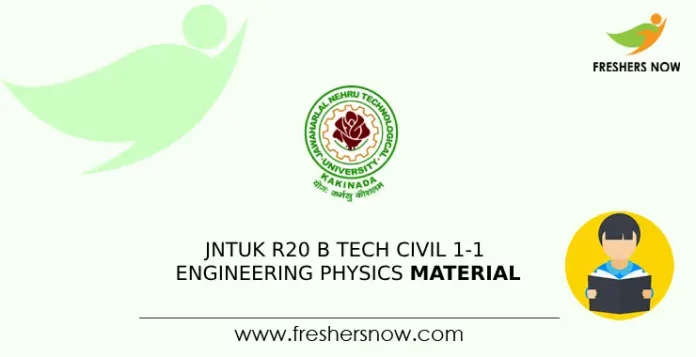
JNTUK R20 B Tech Civil 1-1 Engineering Physics Material/ Notes PDF Download: Our JNTUK R20 B Tech Civil Engineering Physics Material bridges the gap between high school physics and undergraduate engineering courses, ensuring a smooth transition for students. We emphasize the importance of optical phenomena like interference, diffraction, and polarization in engineering applications, offering practical insights into their utility. Moreover, our material delves into the mechanism of light emission, the versatility of lasers for various applications, and the propagation of light through optical fibers, crucial for optical communications. Additionally, we explore the potential applications of dielectric and magnetic materials in microdevices, broadening the scope of engineering possibilities.
JNTUK R20 B Tech Civil Engineering Physics Material – Units
| No. Of Units | Name of the Unit |
| Unit – 1 | Wave Optics |
| Unit – 2 | Lasers and Fiber Optics |
| Unit – 3 | Engineering Materials |
| Unit – 4 | Acoustics and Ultrasonics |
| Unit – 5 | Crystallography and X-ray Diffraction |
Unit 1 Syllabus PDF Download | JNTUK R20 B Tech Civil Engineering Physics Material
Wave Optics
Interference: Principle of superposition –Interference of light – Interference in thin films (Reflection Geometry) & applications -Colors in thin films- Newton’s Rings- Determination of wavelength and refractive index.
Diffraction: Introduction – Fresnel and Fraunhofer diffraction – Fraunhofer diffraction due to single slit, double slit – N-slits(Qualitative) – Grating – Dispersive power and resolving power of Grating(Qualitative).
Polarization: Introduction-Types of polarization – Polarization by reflection, refraction, and Double refraction – Nicol’s Prism -Half wave and Quarter wave plates.
| JNTUK R20 B Tech 1-1 Engineering Physics Material – PDF Download | |
| To Download JNTUK R20 B Tech Engineering Physics Material Unit 1 PDF | Reference 1 | Reference 2 | Reference 3 |
Unit 2 Syllabus PDF Download | JNTUK R20 B Tech Civil Engineering Physics Material
Lasers and Fiber optics
Lasers: Introduction – Characteristics of laser – Spontaneous and Stimulated emissions of radiation – Einstein’s coefficients – Population inversion –Lasing action- Pumping mechanisms – Ruby laser – He-Ne laser – Applications of lasers.
Fiber optics: Introduction –Principle of optical fiber- Acceptance Angle-Numerical ApertureClassification of optical fibers based on refractive index profile and modes –Propagation of electromagnetic wave through optical fibers – Applications.
| JNTUK R20 B Tech 1-1 Engineering Physics Material – PDF Download | |
| To Download JNTUK R20 B Tech Engineering Physics Material Unit 2 PDF | Reference 1 | Reference 2 |
Unit 3 Syllabus PDF Download | JNTUK R20 B Tech Civil Engineering Physics Material
Engineering Materials
Dielectric Materials: Introduction – Dielectric polarization – Dielectric polarizability, Susceptibility, and Dielectric constant – Types of polarizations- Electronic (Quantitative), Ionic (Quantitative) and Orientation polarizations (Qualitative) – Lorentz internal field- Clausius-Mossotti equationPiezoelectricity.
Magnetic Materials: Introduction – Magnetic dipole moment – Magnetization-Magnetic susceptibility and permeability – Origin of permanent magnetic moment – Classification of magnetic materials: Dia, para, Ferro, antiferro & Ferrimagnetic materials – Domain concept for Ferromagnetism & Domain walls (Qualitative) – Hysteresis – soft and hard magnetic materials- Eddy currents- Engineering applications.
| JNTUK R20 B Tech 1-1 Engineering Physics Material – PDF Download | |
| To Download JNTUK R20 B Tech Engineering Physics Material Unit 3 PDF | Download PDF |
Unit 4 Syllabus PDF Download | JNTUK R20 B Tech Civil Engineering Physics Material
Acoustics and Ultrasonics
Acoustics: Introduction – requirements of the acoustically good hall– Reverberation – Reverberation time– Sabine’s formula (Derivation using growth and decay method) – Absorption coefficient and its determination – Factors affecting acoustics of buildings and their remedial measures.
Ultrasonics: Introduction – Properties – Production by magnetostriction and piezoelectric methods – Detection – Acoustic grating – Non-Destructive Testing – a pulse-echo system through transmission and reflection modes – Applications.
| JNTUK R20 B Tech 1-1 Engineering Physics Material – PDF Download | |
| To Download JNTUK R20 B Tech Engineering Physics Material Unit 4 PDF | Reference 1 | Reference 2 |
Unit 5 Syllabus PDF Download | JNTUK R20 B Tech Civil Engineering Physics Material
Crystallography and X-ray diffraction
Crystallography: Space lattice, Basis, Unit Cell, and lattice parameters – Bravais Lattice – crystal systems (3D) – coordination number – packing fraction of SC, BCC & FCC – Miller indices – separation between successive (hkl) planes.
X-ray diffraction: Bragg’s law – X-ray Diffractometer – crystal structure determination by Laue’s and powder methods.
| JNTUK R20 B Tech 1-1 Engineering Physics Material – PDF Download | |
| To Download JNTUK R20 B Tech Engineering Physics Material Unit 5 PDF | Download PDF |
For more details about JNTUK R20 B Tech Civil 1-1 Engineering Physics Material PDF Download and other materials follow our official website Freshersnow.com.
| You Can Also Check | |
| JNTUK R20 B Tech Civil 1-1 Mathematics – I Material | |
| JNTUK R20 B Tech Civil 1-1 English Material | |
JNTUK R20 B Tech Civil 1-1 Engineering Physics Notes – Outcomes:
- Classify various crystal systems.
- Identify different planes in the crystal structure.
- Analyze the crystalline structure with Bragg’s X-ray diffractometer.
- Apply the powder method to measure the crystallinity of a solid.



